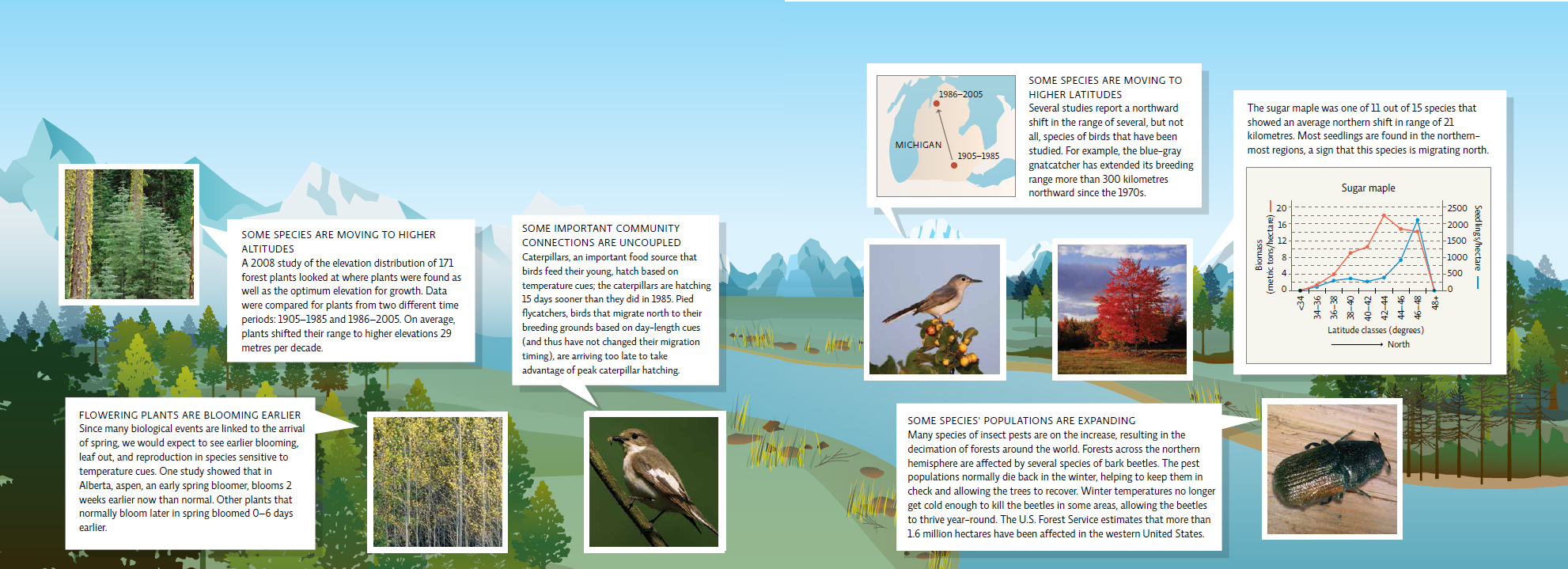22.6 Some tree species are already migrating north; that doesn’t mean they will survive.
Like Frelich, Chris Woodall has spent his entire adult life studying the great forests—both temperate and boreal—that stretch from the northeastern United States well into Canada. Unlike Frelich, Woodall spends most of his time in front of a computer screen, crunching numbers. He works for the U.S. Department of Agriculture’s forest inventory program, which maintains roughly 100 000 permanent plots throughout the region—segments of forest where the USDA monitors a host of variables, from temperature and precipitation to tree growth and sapling density. It’s a tremendous database, and for the past decade, scientists have used it to develop computerized models of how a warmer climate might change forests in the future. But until recently, no one had looked at whether or not they were already changing.
Woodall’s logic was simple: mature trees tell you where the current range is. Seedlings tell you where that range will be in the future. By comparing the ratio of seedlings to mature trees, one should be able to say whether or not any given species is on the move. Using the most recent data collected from 30 states and some 66 000 inventory plots, Woodall compared tree-seedling densities to forest biomass for more than two dozen tree species.
He was astounded by what he found. For most of those species—spruce, jack pine, sugar maple, and several others—the mean location for seedlings proved to be significantly further north than their associated mature trees. “It’s like if they had a gravity centre, it would be pulling them northward.”
Whether they will actually survive in new locations is another story. While studies of the average locations for trees and saplings show northward migration, subsequent studies show contraction, or a loss of trees, at the northern edges. “The obvious question is, ‘Well, how does that reconcile with the findings on mean, that they are moving north?’” Woodall says. “The answer is that it’s like buffalo rushing off a cliff. As climate warms, you’ve got all these species gravitating to the northernmost edges of their traditional ranges. But that doesn’t mean they will survive there long term.”
Back in the North Woods, Frelich is working to understand why. So far, he’s identified several forces that seem to be working in concert. “Warming triggers a whole cascade of events,” he says. “Factors that make tree ranges shift northward, and factors that prevent those trees from thriving in their new, more northerly habitats.”
One of the biggest factors, he says, is deer, which have proliferated like mad in recent years. “In a warmer climate,” Frelich says, “you’d expect the maple to advance in the understory, so that as the spruce die off, the maple are ready to take over. Likewise in the south: as maple move northward in response to warming, oak should move in to fill the void.” But it turns out that deer like maple much more than they like spruce, and oak even more than maple. “So in places where the deer population is very high, the trees are having a hard time adapting to climate change because the deer are eating up all the early migrators.”
“It’s like buffalo rushing off a cliff. As climate warms, you’ve got all these species gravitating to the northernmost edges of their traditional ranges.”
—Chris Woodall
And as climate warms, other stresses abound: snowpack melts earlier, causing more severe water deficits in summer, right when trees need extra water to survive. The whole landscape dries out, creating conditions that favour intense fires and stressing trees so much that they become easy prey for beetle infestation. Pine beetles are a natural part of the life cycle in western forests, but the current outbreak, underway for more than a decade, is unlike anything seen before. “It used to get down to 40 below, every couple years, and that would keep things in check by killing the beetles off,” says Frelich. “But that isn’t happening anymore.” Mountain pine beetle infestation has impacted 18.1 million hectares of British Columbia’s forests.
There are many other indicators that species are responding to climate change. In fact, that they are responding is evidence itself that climate is changing. Because communities are complex assemblages of many species, there are concerns that important community connections will become uncoupled as species respond in different ways to climate change. [infographic 22.9]
